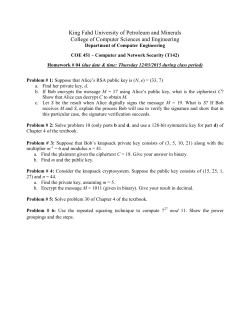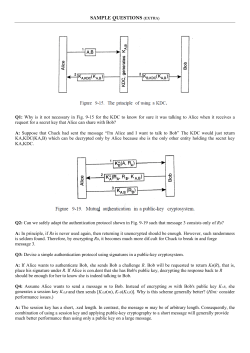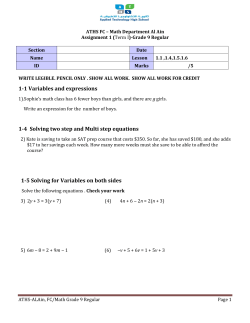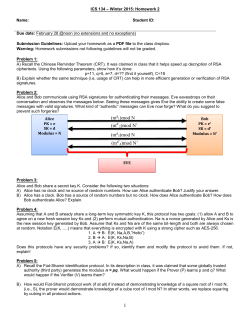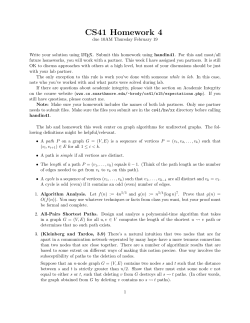
University of Pennsylvania 2015
The Functorial Data Model
Patrick Schultz, David Spivak, Ryan Wisnesky
Department of Mathematics
Massachusetts Institute of Technology
{schultzp, dspivak, wisnesky}@math.mit.edu
Foundational Methods in Computer Science
June 6, 2015
Outline
§
The functorial data model (my name) originated with Rosebrugh et al.
in the late 1990s.
§
§
§
I will describe:
§
§
§
§
§
§
Schemas are categories, instances are set-valued functors.
Spivak proposes using it to solve information integration problems.
Rosebrugh’s original model (the FDM)
How to use the FDM for information integration
Extending the FDM towards SQL (FQL)
Extending the FDM towards functional programming (FPQL)
Conjectures
Sponsored by:
§
§
ONR grant N000141310260
AFOSR grant FA9550-14-1-0031
2 / 31
Category theory
§ A category C consists of
§
§
§
§
§
a set of objects
for all objects X, Y a set CpX, Y q of arrows
for all objects X an arrow id P CpX, Xq
for all objects X, Y, Z a function ˝ : CpY, Zq ˆ CpX, Y q Ñ CpX, Zq
such that f ˝ id “ id and id ˝ f “ f and pf ˝ gq ˝ h “ f ˝ pg ˝ hq
§ A functor F : C Ñ D is a function taking objects in C to objects in D and arrows
f : X Ñ Y in C to arrows F pf q : F pXq Ñ F pY q in D such that F pidq “ id and
F pf ˝ gq “ F pf q ˝ F pgq.
§ A category presentation C consists of
§
§
§
a set of nodes
for all nodes X, Y a set CpX, Y q of edges
a set of path equations
§ A functor presentation F : C Ñ D is a function taking nodes in C to nodes in D
and edges f : X Ñ Y in C to paths F pf q : F pXq Ñ F pY q in D such that
C $ p “ q implies D $ F ppq “ F pqq.
3 / 31
The Functorial Data Model
manager
/ Dept
works
Emp
‚ o
‚
secretary
first
last
name
Dom z
‚
Emp.manager.works “ Emp.works
Dept.secretary.works “ Dept
ID
101
102
103
mgr
103
102
103
Emp
works
q10
x02
q10
first
Al
Bob
Carl
last
Akin
Bo
Cork
ID
q10
x02
Dept
sec name
102
CS
101 Math
Dom
ID
Al
Akin
Bob
Bo
Carl
Cork
CS
Math
4 / 31
Convention
§
Omit Dom table, and draw edges ‚ Ñf ‚Dom as ‚ ´ ˝f :
manager
/ Dept
works
Emp
‚ o
secretary
‚
first
last
name
Dom z
‚
“
manager
works
Emp
‚ o
first
˝
secretary
last
˝
/ Dept
‚
name
˝
5 / 31
The Functorial Data Model (abbreviated)
manager
‚ o
first
name
˝
Emp.manager.works “ Emp.works
mgr
103
102
103
‚
secretary
last
˝
ID
101
102
103
/ Dept
works
Emp
Emp
works
q10
x02
q10
first
Al
Bob
Carl
˝
Dept.secretary.works “ Dept
last
Akin
Bo
Cork
ID
q10
x02
Dept
sec name
102
CS
101 Math
6 / 31
Functorial Data Migration
§
A functor F : S Ñ T is a constraint-respecting mapping:
nodespSq Ñ nodespT q
edgespSq Ñ pathspT q
and it induces three adjoint data migration functors:
§
∆F : T -inst Ñ S-inst (like project)
S
/T
F
I
/ Set
6
∆F pIq :“ I˝F
§
ΠF : S-inst Ñ T -inst (like join)
∆ F % ΠF
§
ΣF : S-inst Ñ T -inst (like outer disjoint union then quotient)
ΣF % ∆ F
7 / 31
∆ (Project)
Name
Name
˝
˝
Salary
Salary
˝
˝
F
ÝÝÝÑ
N1
N2
‚
‚
N
‚
Age
Age
˝
ID
1
2
3
N1
Name
Alice
Bob
Sue
Salary
$100
$250
$300
ID
4
5
6
˝
N2
Age
20
20
30
N
ID
∆
ÐÝFÝ a
b
c
Name
Alice
Bob
Sue
Salary
$100
$250
$300
Age
20
20
30
8 / 31
Π (Join)
Name
Name
˝
˝
Salary
Salary
˝
˝
F
ÝÝÝÑ
N1
N2
‚
‚
N
‚
Age
Age
˝
˝
N
ID
1
2
3
N1
Name
Alice
Bob
Sue
Salary
$100
$250
$300
ID
4
5
6
N2
Age
20
20
30
ID
a
b
c
Π
ÝÝFÑ d
e
f
g
h
i
Name
Alice
Alice
Alice
Bob
Bob
Bob
Sue
Sue
Sue
Salary
$100
$100
$100
$250
$250
$250
$300
$300
$300
Age
20
20
30
20
20
30
20
20
30
9 / 31
Σ (Union)
Name
Name
˝
˝
Salary
Salary
˝
˝
F
ÝÝÝÑ
N1
N2
‚
‚
N
‚
Age
Age
˝
ID
1
2
3
N1
Name
Alice
Bob
Sue
Salary
$100
$250
$300
ID
4
5
6
˝
N2
Age
20
20
30
ID
a
ΣF
b
ÝÝÑ
c
d
e
f
Name
Alice
Bob
Sue
null4
null6
null8
N
Salary
$100
$250
$300
null5
null7
null9
Age
null1
null2
null3
20
20
30
10 / 31
Foreign keys
Name
Name
˝
˝
Salary
Salary
˝
˝
F
ÝÝÝÑ
N1
/ N2
‚
f
‚
N
‚
Age
Age
˝
ID
1
2
3
N1
Name
Alice
Bob
Sue
Salary
$100
$250
$300
f
4
5
6
ID
4
5
6
˝
N2
Age
20
20
30
∆
ÐÝFÝ
ID
ΠF ,ΣF
ÝÝÝÝÝÑ a
b
c
N
Name
Alice
Bob
Sue
Salary
$100
$250
$300
Age
20
20
30
11 / 31
Self-managers
mgr
Emp
‚
F
ÝÝÝÑ
SelfMgr
‚
§
∆F will copy SelfMgr into Mgr, and put the identity into mgr.
§
ΠF will migrate into SelfMgr those Emps who are their own mgr.
§
ΣF will migrate into SelfMgr representatives of the “management
groups” of Emp, i.e. equivalence classes of Emps modulo the
equivalence relation generated by mgr.
§
Adjoints are only unique up to isomorphism; hence, there are many ΣF
functors; each will choose a different representative.
12 / 31
Pivot (Instance ô Schema)
last
q10
CS
‚ o
‚S o
name
101
first
works
102
first / Bob
‚
x02
‚ o name ‚ o
‚Q
works
‚
mgr
works
' Akin
‚
last
mgr
Math
/ Al
‚
103
‚Q
& Bo
‚
last
first / Carl
‚
' Cork
‚
mgr
ID
101
102
103
mgr
103
102
103
Emp
works
q10
x02
q10
first
Al
Bob
Carl
last
Akin
Bo
Cork
ID
q10
x02
Dept
name
CS
Math
13 / 31
Evaluation of the functorial data model
§
Positives:
§
§
§
§
§
§
§
The category of categories is bi-cartesian closed (model of the STLC).
For each category C, the category C-inst is a topos (model of HOL).
Data integrity constraints (path equations) are built-in to schemas.
Data migration functors transform entire instances.
The FDM is expressive enough for many information integration tasks.
Easy to pivot.
Negatives:
§
§
§
§
§
§
Data integrity constraints (in schemas) are limited to path equalities.
Data migrations lack analog of set-difference.
No aggregation.
Data migration functors are hard to program directly.
Instance isomorphism is too coarse for many integration tasks.
Many problems about finitely-presented categories are semi-computable:
§
§
Path equivalence (required to check functors are constraint-respecting).
Generating a category from a presentation (hence the category of
finitely-presented categories is not cartesian closed).
14 / 31
The Attribute Problem
N
ID
1
2
3
Name
Alice
Bob
Sue
Age
20
20
30
Salary
$100
$250
$300
– (good)
N
ID
4
5
6
Name
Alice
Bob
Sue
Age
20
20
30
Salary
$100
$250
$300
– (bad)
N
ID
1
2
3
Name
Amy
Bill
Susan
Age
20
20
30
Salary
$100
$250
$300
15 / 31
Solving the Attribute Problem
§
Mark certain edges to leaf nodes as “attributes”.
§
§
§
§
In this extension, a schema is a category C, a discrete category C0 , and
a functor C0 Ñ C. Instances and migrations also generalize.
Schemas become special ER (entity-relationship) diagrams.
The FDM takes C0 to be empty.
The example schema below, which was an abbreviation in the FDM, is a
bona-fide schema in this extension: attributes are first, last, and name.
manager
works
Emp
‚ o
first
˝
secretary
last
˝
/ Dept
‚
name
˝
16 / 31
Solved Attribute Problem
N
ID
1
2
3
Name
Alice
Bob
Sue
Age
20
20
30
Salary
$100
$250
$300
– (good)
N
ID
4
5
6
Name
Alice
Bob
Sue
Age
20
20
30
Salary
$100
$250
$300
fl (good)
N
ID
1
2
3
Name
Amy
Bill
Susan
Age
20
20
30
Salary
$100
$250
$300
17 / 31
FQL - A Functorial Query Language
§
The “schemas as ER diagrams” extension to the functorial data model
is the basis of FQL.
§
§
Open-source, graphical IDE available at categoricaldata.net/fql.html.
FQL translates data migrations of the form
ΣF ˝ ΠG ˝ ∆H
into SQL and vice versa. Caveats:
§
§
§
§
§
F must be a discrete op-fibration (ensures union compatibility).
G must be a surjection on attributes (ensures domain independence).
All categories must be finite (ensures computability).
FQL ÞÑ SPCU+idgen (sets)
SPCU (bags) ÞÑ FQL, SPCU (sets) ÞÑ FQL+squash
selection equality conjunctive and between variables only.
Theorem: FQL queries are closed under composition.
18 / 31
FQL Demo
19 / 31
FQL evaluation
§
Positives:
§
§
§
§
Negatives:
§
§
§
§
§
Attributes.
Running on SQL enables interoperability and execution speed.
Better Σ semantics than TGD-only systems (e.g., Clio).
No selection by constants.
Relies on fresh ID generation.
Cannot change type of data during migration.
Attributes not nullable.
Apply type-theory to FQL to overcome negatives.
20 / 31
FPQL - a functorial programming and query language
§
FPQL extends FQL schemas to include edges between attributes.
§
§
§
A typing Γ is a category with terminal object.
A schema S on typing Γ is a category extending Γ in a special way.
An instance I on schema S is a category extending S in a special way.
§
Design decision: treat all categories as finitely-presented, and use
monoidal Knuth-Bendix to reduce paths.
§
FPQL instances are deductive databases, not extensional ones.
§
§
FPQL allows inconsistent and infinite databases, if desired.
FPQL cannot be implemented with SQL, but can borrow
implementation techniques from SQL.
21 / 31
Typings
§
A typing is a category with terminal object 1:
1
zero
Nat
_
˝M o
C˝ h
!Nat
!String
String
˝Q
length
reverse
succ
reverse.reverse “ id
§
Implicitly includes, for all well-typed edges e:
id1 “ !1
§
length “ reverse.length
pe : t Ñ 1q “ !t
pe : t Ñ t1 q.!t1 “ !t
Objects are types, arrows are functions.
22 / 31
Schemas
§
A schema over a typing Γ is a category extending Γ with
§
§
§
§
New
New
New
New
objects, called entities.
arrows from entities to entities, called foreign keys.
arrows from entities to types, called attributes.
equations.
manager
‚ o
age
!Emp
zero
Nat
˝M o
/ Dept
works
Emp
‚
secr
first
!Dept
1z
B˝ h
!String
!Nat
length
succ
manager.works “ works
name
String
˝Q
reverse
secr.works “ id
23 / 31
Instances
§
An instance over a schema S is a category extending S with
§
New edges from 1, called variables, such as
bill : 1 Ñ Emp
§
New equations, such as
bill.age “ zero
§
infinity : 1 Ñ Nat
bill.works.secr.manager “ bill
bill.manager “ bill
Tabular view of instances:
ID
bill
bill.works.secr
manager
bill
bill
ID
bill.works
Emp
works
age
bill.works
zero
bill.works
bill.works.secr.age
Dept
secr
bill.works.secr
first
bill.first
bill.works.secr.first
name
bill.works.name
24 / 31
FPQL Example
Nat: type
zero: Nat
succ: Nat -> Nat
String: type
reverse:
String -> String
length:
String -> Nat
eq1: reverse.reverse
= String
S = schema {
I = instance {
nodes
Emp, Dept;
variables
bill : Emp,
infinity : Nat;
edges
age
:
first :
name
:
works :
secr
:
manager:
Emp ->Nat,
Emp ->String,
Dept->String,
Emp ->Dept,
Dept->Emp,
Emp ->Emp;
equations
bill.age = zero,
bill.works
.secr.manager
= bill;
} : S
eq2: reverse.length
= length
equations
manager.works = works,
secr.works = Dept;
}
25 / 31
Data Migration in FPQL
§
When S and T are schemas on typing Γ, a schema morphism
F : S Ñ T is a constraint-respecting mapping
nodespSq Ñ nodespT q
edgespSq Ñ pathspT q
that is the identity on Γ.
§
ΣF is defined to be substitution along F :
v: 1 Ñ X P I
implies
v : 1 Ñ F pXq P ΣF pIq
§
Σ F % ∆ F % ΠF
§
Migrations ΣF ˝ ∆G ˝ ΠF , where F is a discrete op-fibration, are
closed under composition, and can be written in SQL-like syntax.
26 / 31
Flower Syntax in FPQL
manager
works
Emp
‚ o
first
˝
FPQL
select e.first
from Emp as e
where e.manager.manager = e
secr
last
˝
/ Dept
‚
name
˝
SQL
select e.first
from Emp as e, Emp as f
where e.manager = f.ID and
f.manager = e.ID
27 / 31
Uber-Flower Syntax in FPQL
§
Set everyone’s manager to their manager’s manager:
manager
works
Emp
‚ o
first
˝
secr
last
˝
EmpQuery = {
from
Emp as e
attributes
first = e.first
last = e.last
edges
manager =
{e=e.manager.manager}:EmpQuery
works =
{d=e.works}:DeptQuery
} : Emp
/ Dept
‚
name
˝
DeptQuery = {
from
Dept as d
attributes
name = d.name
edges
secr = {e=d.secr}:EmpQuery
} : Dept
28 / 31
Evaluation of FPQL
§
Positives
§
§
§
§
§
§
Flower syntax
Can change type of data
Nullable attributes
Typings allow functional programming
Σ is extremely cheap
Negatives
§
§
§
No special support for cartesian closed typings (λ-calculi)
Categories of instances on a fixed schema are not cartesian closed
Cannot run on SQL
29 / 31
Conjectures
§
An embedded dependency (ED) is a lifting problem.
§
The chase is a left Kan extension.
§
ΣF , ∆F and ∆F , ΠF are reverse data exchanges.
§
For every data migration F : S Ñ T , there exists an X such that F
can be implemented by chasing a set of EDs over S ` T ` X.
30 / 31
Conclusion
§
Initial success using FPQL with NIST
§
Deep connections between the FDM and the relational model
§
Looking for collaborators
§
Future work:
§
§
§
§
§
§
Restrict typings to a particular cartesian closed category, e.g., Java
FQL flowers : SQL flowers as ? : EDs
Aggregation
Generating mappings from matchings
Entity-resolution
Algorithms
31 / 31
© Copyright 2025
